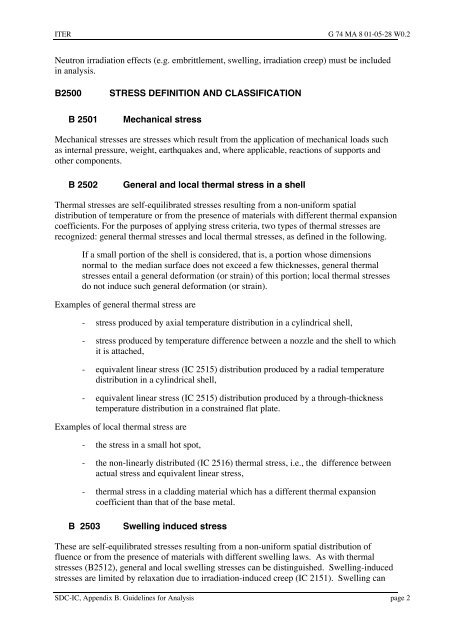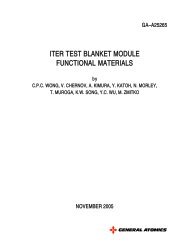iter structural design criteria for in-vessel components (sdc-ic)
iter structural design criteria for in-vessel components (sdc-ic)
iter structural design criteria for in-vessel components (sdc-ic)
You also want an ePaper? Increase the reach of your titles
YUMPU automatically turns print PDFs into web optimized ePapers that Google loves.
ITER G 74 MA 8 01-05-28 W0.2<br />
Neutron irradiation effects (e.g. embrittlement, swell<strong>in</strong>g, irradiation creep) must be <strong>in</strong>cluded<br />
<strong>in</strong> analysis.<br />
B2500 STRESS DEFINITION AND CLASSIFICATION<br />
BÊ2501 Mechan<strong>ic</strong>al stress<br />
Mechan<strong>ic</strong>al stresses are stresses wh<strong>ic</strong>h result from the appl<strong>ic</strong>ation of mechan<strong>ic</strong>al loads such<br />
as <strong>in</strong>ternal pressure, weight, earthquakes and, where appl<strong>ic</strong>able, reactions of supports and<br />
other <strong>components</strong>.<br />
BÊ2502 General and local thermal stress <strong>in</strong> a shell<br />
Thermal stresses are self-equilibrated stresses result<strong>in</strong>g from a non-uni<strong>for</strong>m spatial<br />
distribution of temperature or from the presence of materials with different thermal expansion<br />
coeff<strong>ic</strong>ients. For the purposes of apply<strong>in</strong>g stress cr<strong>iter</strong>ia, two types of thermal stresses are<br />
recognized: general thermal stresses and local thermal stresses, as def<strong>in</strong>ed <strong>in</strong> the follow<strong>in</strong>g.<br />
If a small portion of the shell is considered, that is, a portion whose dimensions<br />
normal to the median surface does not exceed a few th<strong>ic</strong>knesses, general thermal<br />
stresses entail a general de<strong>for</strong>mation (or stra<strong>in</strong>) of this portion; local thermal stresses<br />
do not <strong>in</strong>duce such general de<strong>for</strong>mation (or stra<strong>in</strong>).<br />
Examples of general thermal stress are<br />
- stress produced by axial temperature distribution <strong>in</strong> a cyl<strong>in</strong>dr<strong>ic</strong>al shell,<br />
- stress produced by temperature difference between a nozzle and the shell to wh<strong>ic</strong>h<br />
it is attached,<br />
- equivalent l<strong>in</strong>ear stress (IC 2515) distribution produced by a radial temperature<br />
distribution <strong>in</strong> a cyl<strong>in</strong>dr<strong>ic</strong>al shell,<br />
- equivalent l<strong>in</strong>ear stress (IC 2515) distribution produced by a through-th<strong>ic</strong>kness<br />
temperature distribution <strong>in</strong> a constra<strong>in</strong>ed flat plate.<br />
Examples of local thermal stress are<br />
- the stress <strong>in</strong> a small hot spot,<br />
- the non-l<strong>in</strong>early distributed (IC 2516) thermal stress, i.e., the difference between<br />
actual stress and equivalent l<strong>in</strong>ear stress,<br />
- thermal stress <strong>in</strong> a cladd<strong>in</strong>g material wh<strong>ic</strong>h has a different thermal expansion<br />
coeff<strong>ic</strong>ient than that of the base metal.<br />
BÊ 2503 Swell<strong>in</strong>g <strong>in</strong>duced stress<br />
These are self-equilibrated stresses result<strong>in</strong>g from a non-uni<strong>for</strong>m spatial distribution of<br />
fluence or from the presence of materials with different swell<strong>in</strong>g laws. As with thermal<br />
stresses (B2512), general and local swell<strong>in</strong>g stresses can be dist<strong>in</strong>guished. Swell<strong>in</strong>g-<strong>in</strong>duced<br />
stresses are limited by relaxation due to irradiation-<strong>in</strong>duced creep (IC 2151). Swell<strong>in</strong>g can<br />
SDC-IC, Appendix B. Guidel<strong>in</strong>es <strong>for</strong> Analysis page 2




